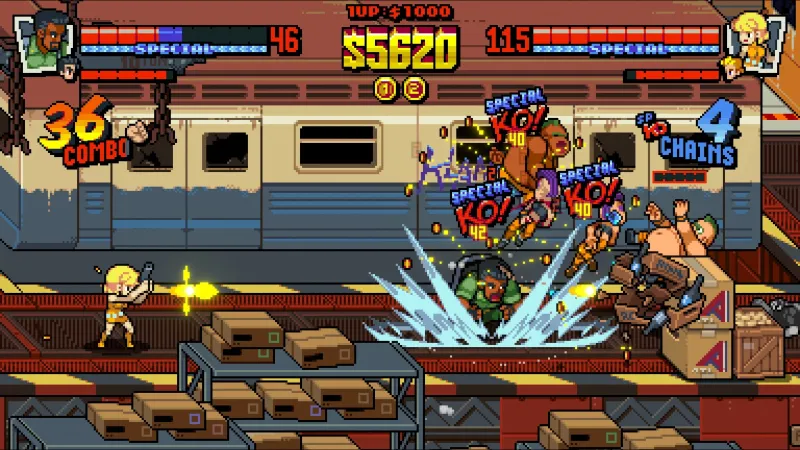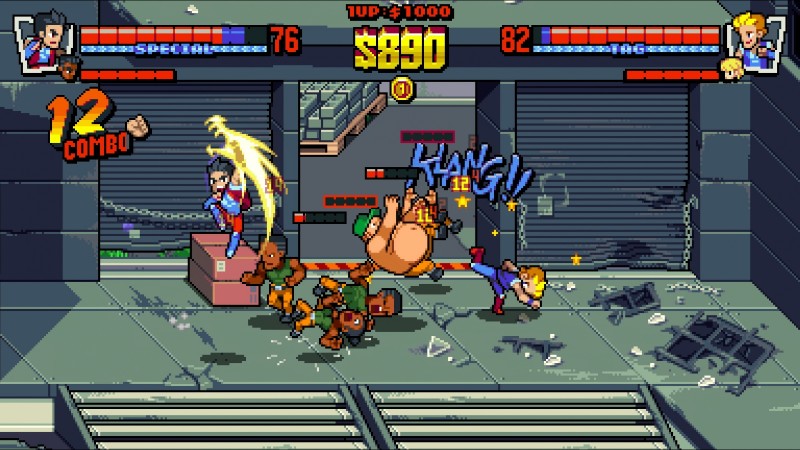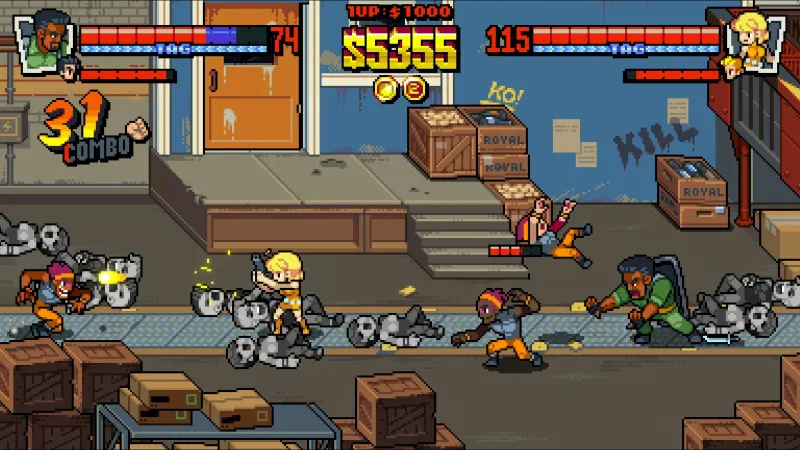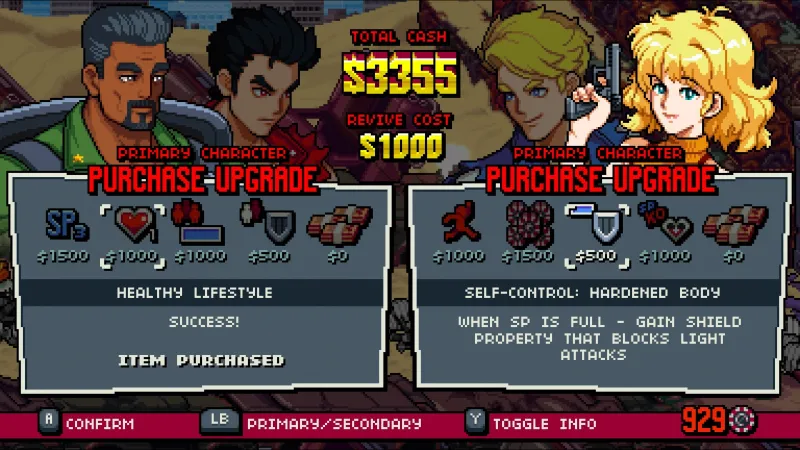Double Dragon Gaiden: Rise Of The Dragons Review – Tag Team Turmoil
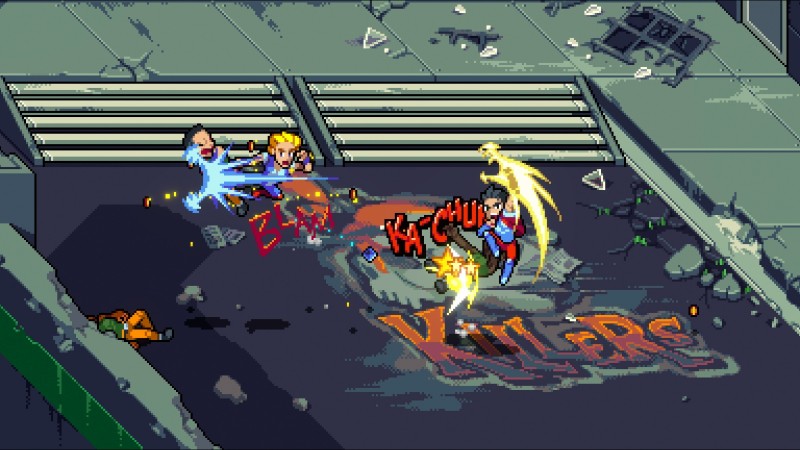
Reviewed on: Switch
Platform: PlayStation 5, Xbox Series X/S, PlayStation 4, Xbox One, Switch, PC
Publisher: Modus Games
Developer: Secret Base
Release:
Rating: Everyone 10+
Double Dragon may be one of the original pillars of the beat ‘em up genre, but that foundation has weakened in modern times. Infrequent sequels of varying quality have tested Jimmy and Billy Lee’s modern relevance, but Double Dragon Gaiden does a solid job of reinventing the pair with a neat tag team mechanic. Though as enjoyable as this contemporary throwback can be, it often gets in its own way with frustrating combat design.
Billy and Jimmy join playable characters Marian and newcomer Uncle Matin to do what they do best: unleash flashy martial arts to clean up their gang-ridden streets. Each character offers a very different attack style. Marian’s expertise with firearms and gadgets makes her ideal for long-range combat, while Uncle Matin’s brute strength and riot shield lets him annihilate opponents up close. Even Jimmy and Billy are different, with the former being more agile and the latter hitting a little slower but harder. Jimmy became my favorite character due to his maneuverability and general well-roundedness, to the point that tagging in others felt like a downgrade. Heroes aren’t created equal; for example, some don’t have effective jump attacks, making them a pain to use against airborne threats.
Whether you fight crime alone or alongside a friend in co-op (local only; online play arrives in a post-launch patch), you control two heroes in tag team play. Hitting a shoulder button swaps characters, and the mechanic provides a decent avenue to extend combo strings or, better yet, escape when one character gets caught by enemy offense.
The generally adequate combat is most satisfying when I’m juggling foes until they explode into a shower of coins or using special attacks to send targets colliding into their friends. I also like how the game rewards health items for killing multiple enemies simultaneously, encouraging thoughtful crowd control and aggression. However, the game’s impressively fluid animation comes at the cost of snappiness. Attacks have an over-animated, delayed feel that takes a while to get used to. Vertical movement feels painfully slow, making dodging stage hazards such as falling rocks or random lightning strikes a frustrating exercise.
I wish picking up items and grappling didn’t share the same button. Missing a grab leaves you briefly vulnerable to attack, but this mainly occurred when I was trying to snag a weapon and was a pixel off the mark. Due to the genre's historically tricky act of lining yourself up on the same plane as your target, I ate a ton of damage from this annoying slip-up. That brings me to Double Dragon Gaiden’s biggest headache: enemies can stun-lock you into oblivion. In tight spots filled with tons of foes, getting helplessly trapped in combos can instantly drain a health bar. Tagging in a partner is the only way to break free, but there’s no invincibility window.
Thus, I had several instances of summoning help, only for my partner to leap into a flurry of attacks and die before I even gained control. Tagging out a damaged hero only for him to perish because he didn’t leave fast enough is equally irksome. You could argue this encourages strategic tagging, but with so much going on at once, you can’t always predict who will attack next or when. Worse, enemies often attack from offscreen. Nothing’s worse than surviving a mob of tough enemies only to die from a stray bullet by a hidden gunman. The maddeningly arduous final stage encompasses all of these annoyances, especially once it pits every boss against players at once. Navigating their overwhelmingly unfair medley of debilitating special attacks made me want to chuck my controller into a wall.
You can mitigate these hardships by adding character enhancements from a randomized selection between stages. Perks include better combo effectiveness to helpful boons, like granting full health to incoming partners after their ally dies, but there’s no guarantee you’ll get the boost you need. Collected coins buy Continues after a Game Over, but the cost raises every subsequent death, making a cheap loss feel even more devastating. Cashing out coins earns tokens spent to buy checkpoints once you run out of lives, which is their best use case since it prevents starting over from scratch. Tokens also unlock new playable characters or less appealing bonus material like digital art and music tracks.
I do admire the evolving level of progression. You can tackle the four main stages in any order, with the first stage offering an easier journey within a single section. The next level adds one more area and raises the difficulty, sub-bosses, rewards, etc. Thus, whichever level you save for last becomes a lengthy and challenging multi-part gauntlet. Monotony is a beat ‘em up’s biggest drawback, and this is a neat remedy that inspired me to replay the game to see the full versions of the levels I chose to tackle early.
Double Dragon Gaiden: Rise of the Dragons has some aggravating design choices that prevent it from reaching the heights of similar comebacks like TMNT or newcomers like Young Souls, but this is a respectable return for the Lee brothers. If you’re hankering to punch goons in the face, a good time can be had as long as you bring a measure of patience.
Score: 7.25
About Game Informer's review system
Purchasesource https://www.gameinformer.com/review/double-dragon-gaiden-rise-of-the-dragons/tag-team-turmoil

